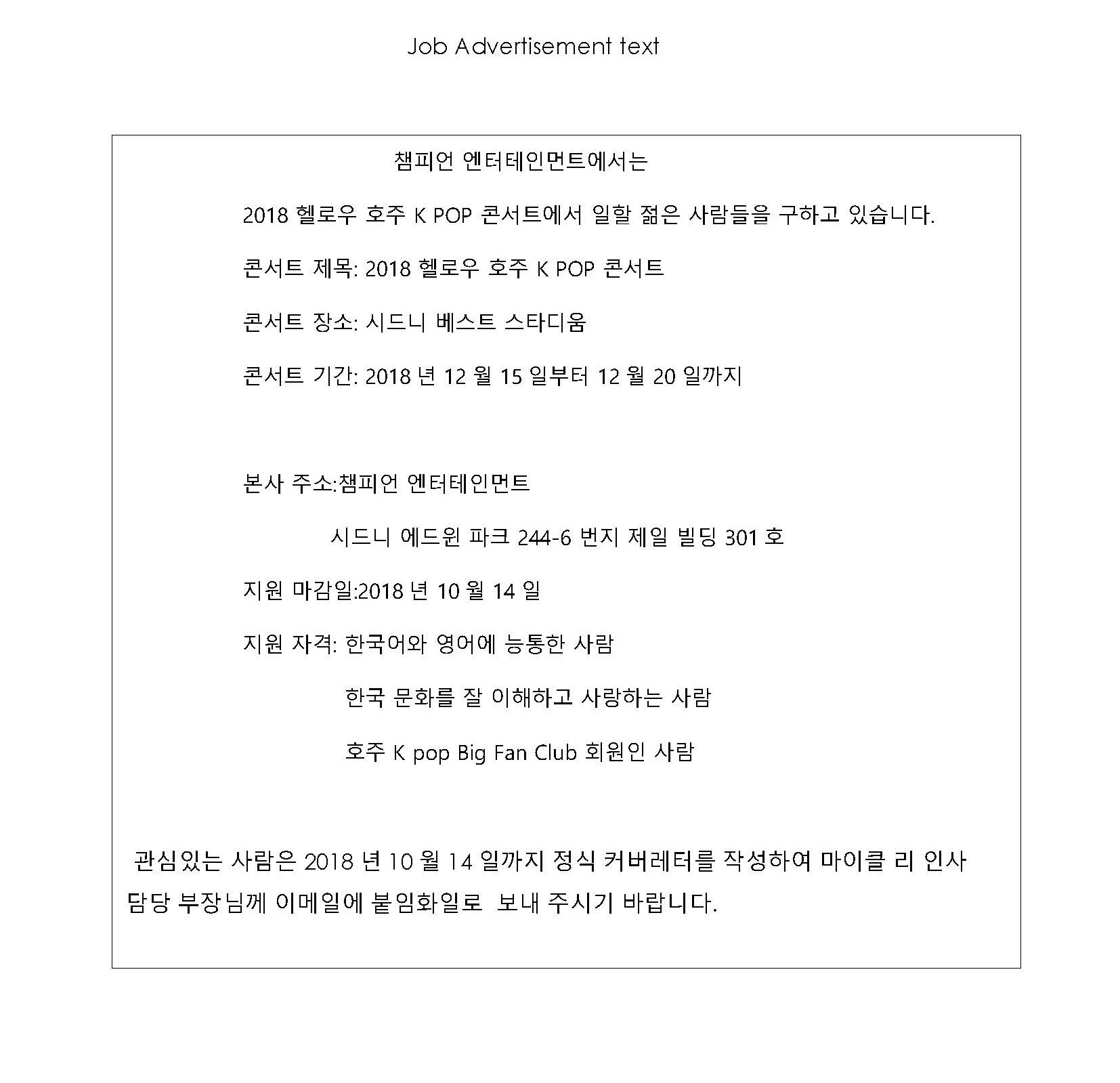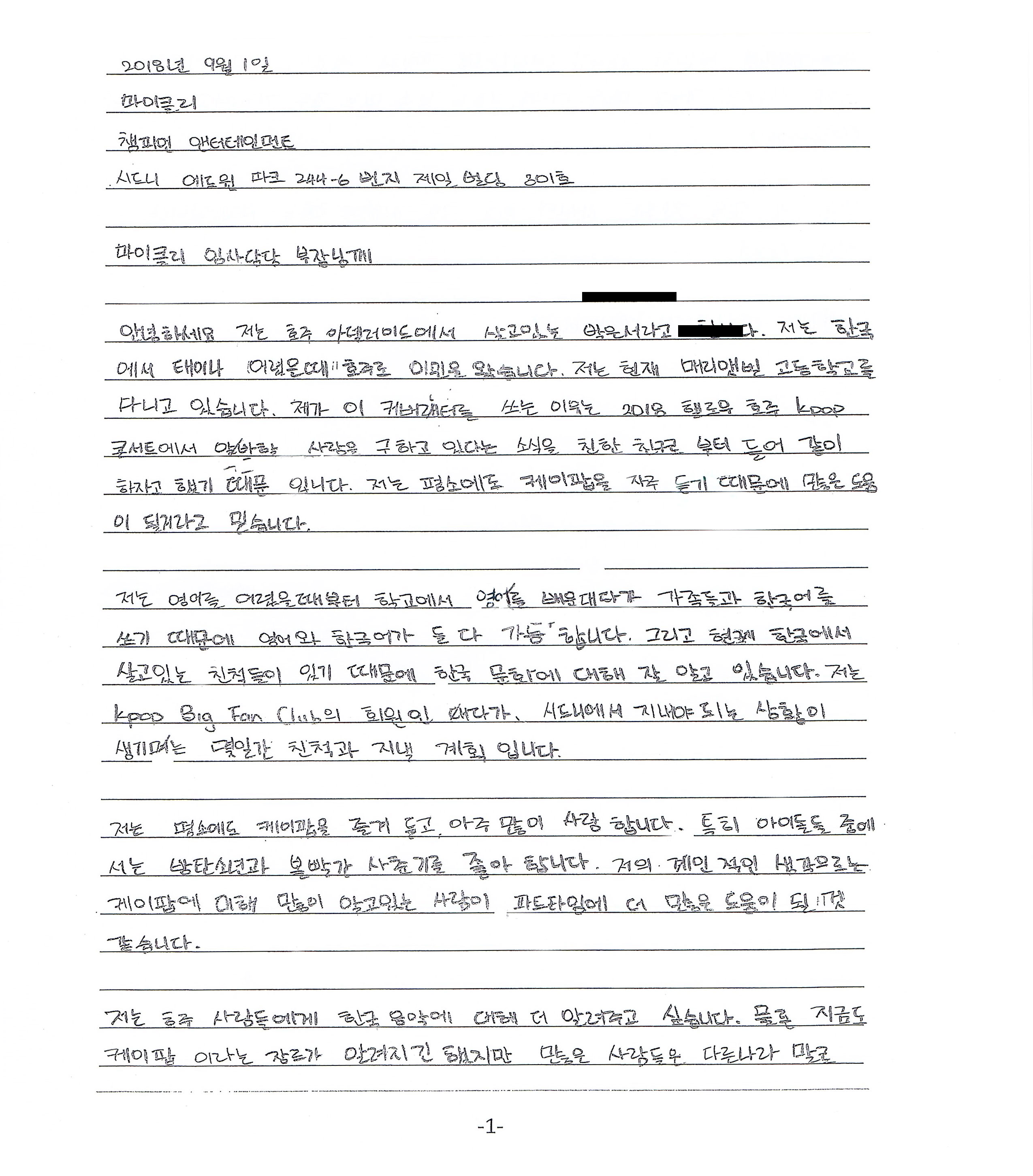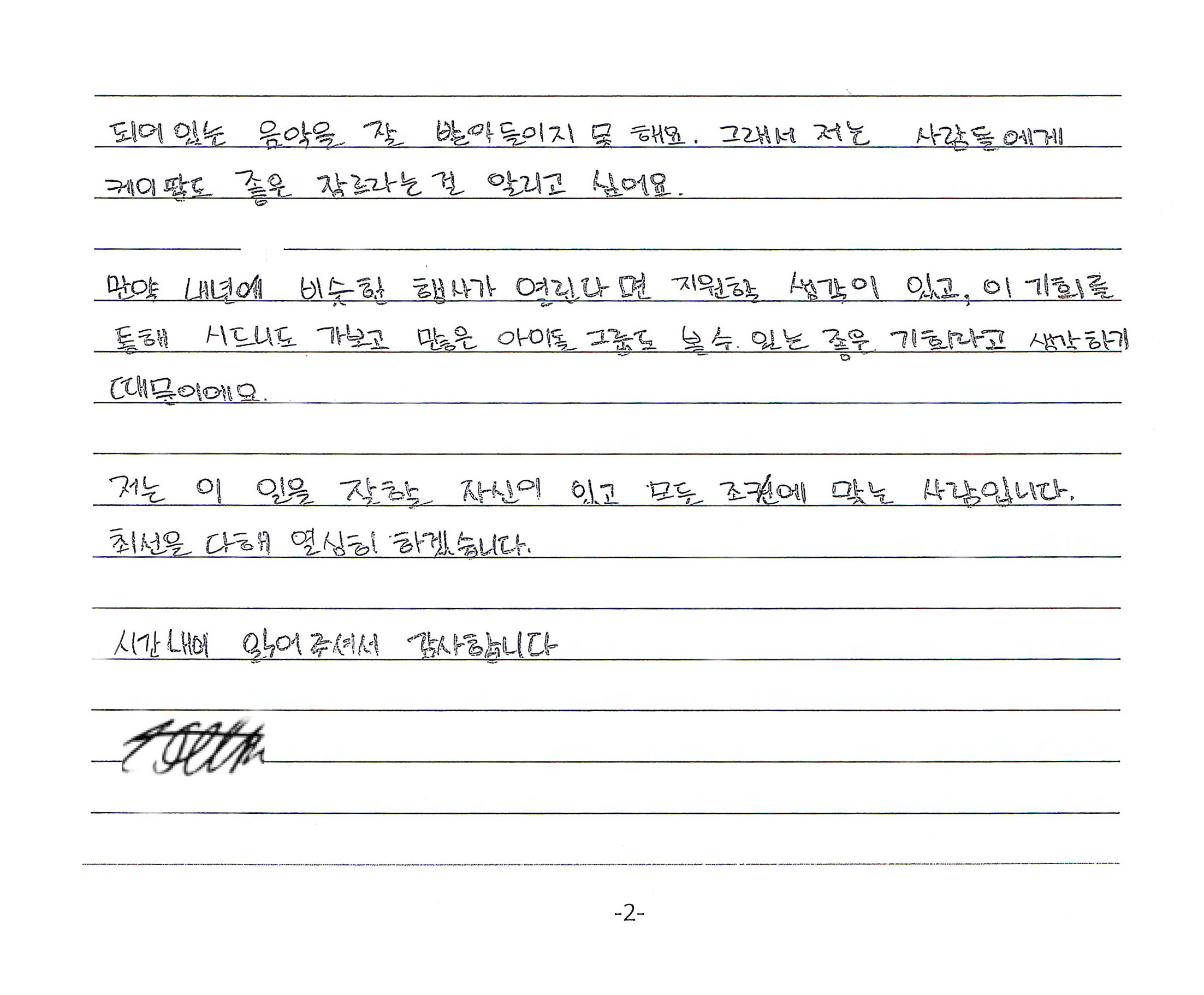- Home
- Resources
- Work samples
- Samples
- Job application and interview – AT
Job application and interview
Summary of task
Students learnt about jobs and careers. They read a range of texts in relation to jobs, including informative texts and advertisements. They learnt how to write a formal job application, responding to advertised criteria and using vocabulary, register and language structures appropriate to the text type.
This task had two parts:
In Part 1, students were asked to read an advertisement for a part-time position at a K-pop entertainment company in Sydney, then write a formal application letter in response, addressing the job criteria and presenting their credentials for the position.
In Part 2, students participated in an interview for the position, with the teacher as interviewer.
Students were given feedback before the final tasks were completed.
Achievement standard
By the end of Year 10, students use written and spoken Korean to communicate with teachers, peers and others in a range of settings and for a range of purposes. They use Korean to access and exchange information on a broad range of social, cultural and environmental issues of interest to young people. They initiate, sustain and extend spoken and written exchanges in interactions and transactions by asking and responding to open-ended questions, eliciting opinions (for example, 어떻게 생각해요?; 어디에서 …–(으)면 좋을까요?), requesting elaboration (for example, 왜 …을/를 좋아해요?; 어떻게 그렇게 되었어요?) and providing their own opinions (for example, 저는 민수가 맞다고 생각해요; 저는 4번이라고 생각했어요) and information when requested. They use non-verbal communication strategies such as facial expressions, gestures, pausing or pitching, and give verbal feedback expressing empathy, down-toning, acknowledging or expressing indirect disagreement using reflective language (such as 그렇지요?; 좋았겠어요; 아마; 글쎄요; 아, 그렇군요; 아닌 것 같은데요; 정말 그럴까요?). They make suggestions in relation to topics of conversation (for example, 여러분도 한번 한국에 가 보세요) and consider options, using a range of suffixes and complex/idiomatic structures indicating the future in verb phrases (such as –겠–, –(으)ㄹ래요, –(으)ㄹ 계획이에요, –(으)ㄹ 거예요, –(으)면 좋을까요?). They make decisions comparing options using ...보다 더 ... and providing reasons for decisions (for example, 기차가 버스보다 더 편리하니까 기차로 가요). Students locate and evaluate information from a range of sources, and analyse, interpret and integrate information from diverse perspectives. They create informative and imaginative texts, using a range of case markers, including honorific forms, particles and verb phrases in complex structures (such as –지 않다/못하다, –(으)ㄹ 뻔하다, –(으)ㄴ/는/(으)ㄹ것 같다, –러 가다), and describing two related ideas or events in different relationships by connecting two clauses in a sentence (for example, 비가 올 것 같으니까 우산을 가져 가세요; 저기에서 노래하는 사람이 누구예요?). They use a range of abstract words, selecting vocabulary suitable for the target audience, purpose and context. They maintain the cohesiveness of the text by keeping consistency in terms of speech level and style and honorific elements, and by using cohesive devices such as conjunctors (such as –(으)니까, –다가, –(으)ㄴ/는데, –(으)면서), conjunctive adverbs (such as 하지만, 그러므로, 그러니까) and ellipsis. Students translate and create bilingual texts across Korean and English, providing and comparing alternative versions, identifying ways to interpret and convey embedded meanings in culture-specific terms or expressions that are language-specific. They compare their intercultural experiences, referencing their current and past senses of identity, views and attitudes in relation to their ways of using language.
Students describe how spoken and written Korean vary and are modified according to contexts, audiences and purposes. They exemplify such adjustments (for example, changes to pitch or speed of speech, use of contractions or 반말, choice of vocabulary, and level of politeness and formality), explaining possible reasons for particular adjustments. They describe how languages change and borrow from, build on and blend with each other, giving examples in relation to Korean and languages such as English, Chinese and Japanese that share social, cultural and historical relationships. They explain how language influences ways of thinking, views of the world and human relationships. Students use metalanguage to explain aspects of the Korean language such as tense, suffix, honorification, adverb, modification, speech level (for example, 반말, 높임말), and politeness. They assess their own language use and cultural practices from multicultural perspectives and the meaning and impact of multiculturalism from various perspectives.
Annotations overview
Follows text type conventions, sequence and layout and uses a range of persuasive writing techniques

 1
Annotation 1
1
Annotation 1
Includes relevant information necessary for application 2 Annotation 2
Uses appropriate introduction and forms of address 3 Annotation 3
Uses present continuous form to indicate current status 4 Annotation 4
Expresses intention and highlights reason for application 5 Annotation 5
Analyses stimulus text and incorporates relevant information in response 6 Annotation 6
Shares personal opinion and experiences to support application and add emphasis
-
Annotations
-
1
Annotation 1
Includes relevant information necessary for application -
2
Annotation 2
Uses appropriate introduction and forms of address -
3
Annotation 3
Uses present continuous form to indicate current status -
4
Annotation 4
Expresses intention and highlights reason for application -
5
Annotation 5
Analyses stimulus text and incorporates relevant information in response -
6
Annotation 6
Shares personal opinion and experiences to support application and add emphasis
 1
Annotation 1
1
Annotation 1
States wishes/desires using a range of complex structures, case markers, particles and polite verb endings 2 Annotation 2
es conjunctions and cohesive devices to relate ideas and link clauses 3 Annotation 3
Selects context, purpose and audience appropriate vocabulary 4 Annotation 4
Concludes logically with formal ending
-
Annotations
-
1
Annotation 1
States wishes/desires using a range of complex structures, case markers, particles and polite verb endings -
2
Annotation 2
es conjunctions and cohesive devices to relate ideas and link clauses -
3
Annotation 3
Selects context, purpose and audience appropriate vocabulary -
4
Annotation 4
Concludes logically with formal ending
Annotations overview
Maintains honorific and polite language throughout interaction using a range of forms, vocabulary and grammar structures